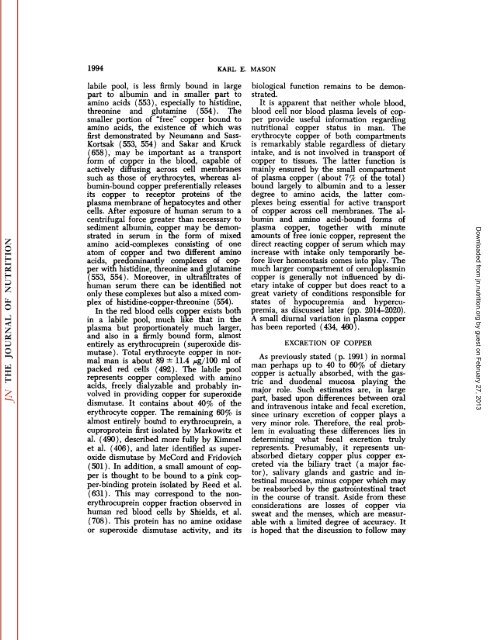conspectus of researchon copper metabolism and requirements
conspectus of researchon copper metabolism and requirements
conspectus of researchon copper metabolism and requirements
You also want an ePaper? Increase the reach of your titles
YUMPU automatically turns print PDFs into web optimized ePapers that Google loves.
1994 KARL E. MASON<br />
labile pool, is less firmly bound in large<br />
part to albumin <strong>and</strong> in smaller part to<br />
amino acids (553), especially to histidine,<br />
threonine <strong>and</strong> glutamine (554). The<br />
smaller portion <strong>of</strong> "free" <strong>copper</strong> bound to<br />
amino acids, the existence <strong>of</strong> which was<br />
first demonstrated by Neumann <strong>and</strong> Sass-<br />
Kortsak (553, 554) <strong>and</strong> Sakar <strong>and</strong> Kruck<br />
(658), may be important as a transport<br />
form <strong>of</strong> <strong>copper</strong> in the blood, capable <strong>of</strong><br />
actively diffusing across cell membranes<br />
such as those <strong>of</strong> erythrocytes, whereas al<br />
bumin-bound <strong>copper</strong> preferentially releases<br />
its <strong>copper</strong> to receptor proteins <strong>of</strong> the<br />
plasma membrane <strong>of</strong> hepatocytes <strong>and</strong> other<br />
cells. After exposure <strong>of</strong> human serum to a<br />
centrifugal force greater than necessary to<br />
sediment albumin, <strong>copper</strong> may be demon<br />
strated in serum in the form <strong>of</strong> mixed<br />
amino acid-complexes consisting <strong>of</strong> one<br />
atom <strong>of</strong> <strong>copper</strong> <strong>and</strong> two different amino<br />
acids, predominantly complexes <strong>of</strong> cop<br />
per wittìhistidine, threonine <strong>and</strong> glutamine<br />
(553, 554). Moreover, in ultrafiltrates <strong>of</strong><br />
human serum there can be identified not<br />
only these complexes but also a mixed com<br />
plex <strong>of</strong> histidine-<strong>copper</strong>-threonine (554).<br />
In the red blood cells <strong>copper</strong> exists both<br />
in a labile pool, much like that in the<br />
plasma but proportionately much larger,<br />
<strong>and</strong> also in a firmly bound form, almost<br />
entirely as erythrocuprein ( Superoxide dismutase).<br />
Total erythrocyte <strong>copper</strong> in nor<br />
mal man is about 89 ±11.4 /¿g/100ml <strong>of</strong><br />
packed red cells (492). The labile pool<br />
represents <strong>copper</strong> complexed with amino<br />
acids, freely dialyzable <strong>and</strong> probably in<br />
volved in providing <strong>copper</strong> for Superoxide<br />
dismutase. It contains about 4Q% <strong>of</strong> the<br />
erythrocyte <strong>copper</strong>. The remaining 60% is<br />
almost entirely bouYid to erythrocuprein, a<br />
cuproprotein first isolated by Markowitz et<br />
al. (490), described more fully by Kimmel<br />
et al. (406), <strong>and</strong> later identified as superoxide<br />
dismutase by McCord <strong>and</strong> Fridovich<br />
(501). In addition, a small amount <strong>of</strong> cop<br />
per is thought to be bound to a pink cop<br />
per-binding protein isolated by Reed et al.<br />
(631). This may correspond to the nonerythrocuprein<br />
<strong>copper</strong> fraction observed in<br />
human red blood cells by Shields, et al.<br />
(708). This protein has no amine oxidase<br />
or Superoxide dismutase activity, <strong>and</strong> its<br />
biological function remains to be demon<br />
strated.<br />
It is apparent that neither whole blood,<br />
blood cell nor blood plasma levels <strong>of</strong> cop<br />
per provide useful information regarding<br />
nutritional <strong>copper</strong> status in man. The<br />
erythrocyte <strong>copper</strong> <strong>of</strong> both compartments<br />
is remarkably stable regardless <strong>of</strong> dietary<br />
intake, <strong>and</strong> is not involved in transport <strong>of</strong><br />
<strong>copper</strong> to tissues. The latter function is<br />
mainly ensured by the small compartment<br />
<strong>of</strong> plasma <strong>copper</strong> (about 7c/f <strong>of</strong> the total)<br />
bound largely to albumin <strong>and</strong> to a lesser<br />
degree to amino acids, the latter com<br />
plexes being essential for active transport<br />
<strong>of</strong> <strong>copper</strong> across cell membranes. The al<br />
bumin <strong>and</strong> amino acid-bound forms <strong>of</strong><br />
plasma <strong>copper</strong>, together with minute<br />
amounts <strong>of</strong> free ionic <strong>copper</strong>, represent the<br />
direct reacting <strong>copper</strong> <strong>of</strong> serum which may<br />
increase with intake only temporarily be<br />
fore liver homeostasis comes into play. The<br />
much larger compartment <strong>of</strong> ceruloplasmin<br />
<strong>copper</strong> is generally not influenced by di<br />
etary intake <strong>of</strong> <strong>copper</strong> but does react to a<br />
great variety <strong>of</strong> conditions responsible for<br />
states <strong>of</strong> hypocupremia <strong>and</strong> hypercupremia,<br />
as discussed later (pp. 2014-2020).<br />
A small diurnal variation in plasma <strong>copper</strong><br />
has been reported (434, 460).<br />
EXCRETION OF COPPER<br />
As previously stated (p. 1991) in normal<br />
man perhaps up to 40 to 60% <strong>of</strong> dietary<br />
<strong>copper</strong> is actually absorbed, with the gas<br />
tric <strong>and</strong> duodenal mucosa playing the<br />
major role. Such estimates are, in large<br />
part, based upon differences between oral<br />
<strong>and</strong> intravenous intake <strong>and</strong> fecal excretion,<br />
since urinary excretion <strong>of</strong> <strong>copper</strong> plays a<br />
very minor role. Therefore, the real prob<br />
lem in evaluating these differences lies in<br />
determining what fecal excretion truly<br />
represents. Presumably, it represents unabsorbed<br />
dietary <strong>copper</strong> plus <strong>copper</strong> ex<br />
creted via the biliary tract (a major fac<br />
tor), salivary gl<strong>and</strong>s <strong>and</strong> gastric <strong>and</strong> in<br />
testinal mucosae, minus <strong>copper</strong> which may<br />
be reabsorbed by the gastrointestinal tract<br />
in the course <strong>of</strong> transit. Aside from these<br />
considerations are losses <strong>of</strong> <strong>copper</strong> via<br />
sweat <strong>and</strong> the menses, which are measur<br />
able with a limited degree <strong>of</strong> accuracy. It<br />
is hoped that the discussion to follow may<br />
Downloaded from<br />
jn.nutrition.org<br />
by guest on February 27, 2013
















